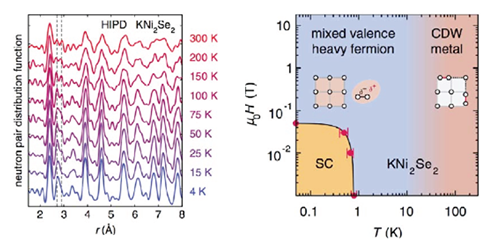News & Media

Highlights
Design and manipulation of macroscopic quantum states in materials
Researchers from DOE's Institute for Quantum Matter at Johns Hopkins University collaborated with Anna Llobet (Lujan Neutron Scattering Center, LANSCE-LC) to discover a new driving force for the emergence of highly entangled quantum states of matter: a mixed-valence-driven heavy fermion state in KNi2Se2. The finding is relevant to a class of materials called "heavy-fermions," metals in which the conduction electrons behave as though they have a mass 10-1000 times that of a normal electron. This happens in systems where individual magnetic electrons become indistinguishable as a result of strong interactions with a bath of non-magnetic conduction electrons. The result is an overall non-magnetic state that is coherent across the material, causing deviations from traditional solid-state theory and behavior. The journal Physical Review B published the research.
 The paper presents the discovery of a new class of heavy-fermion materials in which the fundamental interaction that gives rise to the emergent electronic state is electrostatically driven, rather than magnetically. The scientists used pair distribution function analysis of neutron total scattering data from the LANSCE Lujan Center. The researchers first observed a local distortion in KNi2Se2 that disappeared on cooling the sample, a highly unusual and rare structural trend. This distortion, an aperiodic charge density wave (CDW) reflects the fluctuations of nearly localized charges. The disappearance is accompanied by the formation of a "heavy" electronic mass state, which indicates a quantum mechanical hybridization of the electronic states. Superconductivity emerges from the heavy-mass state at a temperature of 0.80(1) K. This discovery is important in the quest for new exotic states of matter because it demonstrates a new strategy for the design and manipulation of large-scale quantum states and energy harvest and conservation.
The paper presents the discovery of a new class of heavy-fermion materials in which the fundamental interaction that gives rise to the emergent electronic state is electrostatically driven, rather than magnetically. The scientists used pair distribution function analysis of neutron total scattering data from the LANSCE Lujan Center. The researchers first observed a local distortion in KNi2Se2 that disappeared on cooling the sample, a highly unusual and rare structural trend. This distortion, an aperiodic charge density wave (CDW) reflects the fluctuations of nearly localized charges. The disappearance is accompanied by the formation of a "heavy" electronic mass state, which indicates a quantum mechanical hybridization of the electronic states. Superconductivity emerges from the heavy-mass state at a temperature of 0.80(1) K. This discovery is important in the quest for new exotic states of matter because it demonstrates a new strategy for the design and manipulation of large-scale quantum states and energy harvest and conservation.
Reference: "Mixed-valence-driven Heavy-fermion Behavior and Superconductivity in KNi2Se2," Physical Review B 86, 054512 (2012). Researchers include James R. Neilson, Andreas V. Stier, Liang Wu, Jiajia Wen, Zlatko B. Tesanovic, N. P. Armitage, and Tyrel M. McQueen (Johns Hopkins University); Anna Llobet (Lujan Center, LANSCE-LC); Jing Tao and Yimei Zhu (Brookhaven National Laboratory).
The DOE Office of Basic Energy Sciences, Division of Materials Science and Engineering funded the LANL work, which benefited from the use of the high-intensity powder diffractometer (HIPD) and the neutron powder diffractometer (NPDF) at LANL's Lujan Neutron Scattering Center. Scientists performed a portion of this research at the National High Magnetic Field Laboratory (Tallahassee, FL), which the National Science Foundation, the State of Florida, and the DOE sponsor. The work supports the Laboratory's Energy Security mission area and the Materials for the Future science pillar.
Technical contact: Anna Llobet Megias

